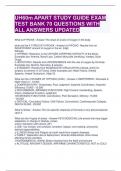UH60m APART STUDY GUIDE EXAM
TEST BANK 70 QUESTIONS WITH
ALL ANSWERS UPDATED
What is HYPOXIA - Answer-The result of a lack of Oxygen in the body.
what are the 4 TYPES OF HYPOXIA - Answer-o HYPOXIC- Results from an
INSUFFICIENT amount of oxygen in the air. (High
Altitude)
o HYPEMIC- Reduction in the OXYGEN CARRYING CAPACITY of the blood.
Examples are; Anemia, Blood Loss, Carbon Monoxide (smoking), nitrates, Sulfa
Drugs.
o HISTOTOXIC- Results from INTERFERENCE with the use of oxygen by the body.
Examples are; Alcohol, Narcotics, & poisons.
o STAGNANT- Results from INADEQUATE CIRCULATION of blood, which for
aviators is common in G Forces. Other examples are; Heart Failure, Arterial
Spasms, Vessel Occlusions. (High G)
What are the 4 STAGES OF HYPOXIA (ICDC) - Answer-o INDIFFERENT- Decrease in
Night Vision 0 - 10,000
o COMPENSATORY -Drowsiness, Poor Judgment, Impaired Coordination, Impaired
Efficiency 10,000 - 15,000'
o DISTURBANCE- IMPAIRED FUNCTIONS: Flight Control, Handwriting, Speech,
Vision, Intellectual Function, Judgment.
DECREASED FUNCTIONS: Coordination, Pain Sensation, Memory. 15,000
- 20,000'
o CRITICAL- Circulatory Failure, CNS Failure, Convulsions, Cardiovascular Collapse,
DEATH 20,000 - 25,000'
What is Stress - Answer-The non-specific response of the body to any demand placed
upon it.
What are the 4 types of stress - Answer-PSYCHOSOCIAL-Life events that may trigger
adaptation or change in lifestyle, career,
and/or interaction with others (JIF)
o JOB - low morale, unit cohesion, boredom, fatigue, over tasking, and poorly
defined responsibilities.
o ILLNESS-Stress and Fatigue can both result from organic diseases.
o FAMILY -Separation due to deployment, strained relationships, other stress
affecting family members
ENVIRONMENTAL (A³HSI) Stress resulting from the flight environment.
o ALTITUDE, AIRCRAFT DESIGN, AIRFRAME CHARACTERISTICS, HOT or COLD
, ENVIRONMENTS, SPEED, INSTRUMENT FLIGHT CONDITIONS-
PHYSIOLOGICAL- Self-imposed stresses.
o (DEATH) DRUGS, EXHAUSTION, ALCOHOL, TOBACCO, HYPOGLYCEMIA
COGNITIVE- (MFC) How an individual perceives situations or problems and their
reaction
to it. Must/Should, Choice/No Choice, Failure to focus on here & now
What is Fatigue - Answer-The state of feeling tired, weary, or sleepy that results from
prolonged mental or physical work,
extended periods of anxiety, exposure to harsh environments, or loss of sleep.
What are the TYPES OF FATIGUE - Answer-ACUTE-Occurs at the end of a long duty
day (approx. 12 - 15 hours) and can typically be
recovered from after one sleep period
CHRONIC-Chronic fatigue is typically the result of inadequate recovery from
successive
periods of acute fatigue. Mental tiredness begins to accompany physical tiredness.
Several weeks of rest may be required for recovery.
MOTIVATIONAL EXHAUSTION (BURNOUT)- If chronic fatigue is allowed to continue
untreated for too long, the individual will eventually "shut down" and cease functioning
occupationally and socially.
What is SPATIAL DISORIENTATION - Answer-An individual's inability to determine
position, altitude, and motion relative to the surface of
the earth or significant objects
What are the 3 TYPES of Spatial Disorientation - Answer-TYPE I-Unrecognized (Most
Dangerous)
TYPE II-Recognized
TYPE III-Incapacitating
what are your SENSORY SYSTEMS - Answer-VISUAL (EYE) 80%
VESTIBULAR (EAR) 15%
SOMATOGYRAL ILLUSIONS
SOMATOGRAVIC ILLUSIONS
PROPRIOCEPTIVE (BODY) 5%
What are your VISUAL ILLUSIONS - Answer-(FFF CRASH SCAR)
FALSE HORIZONS: Clouds may be confused with the horizon.
FLICKER VERTIGO: A light flickering at 4 to 20 cycles per second can cause an
uneasy feeling.
FASCINATION/FIXATION: Fixing your attention on a target or goal.
CONFUSION W/ GROUND LIGHTS: Unable to distinguish between stars and ground
lights.
RELATIVE MOTION: Mistaking another aircraft motion as your own.




